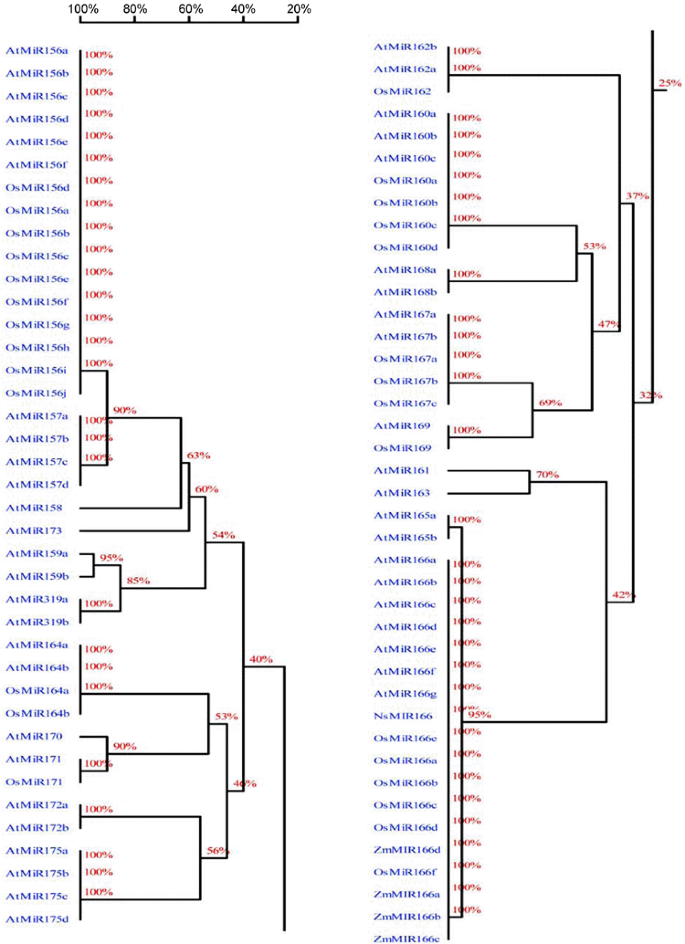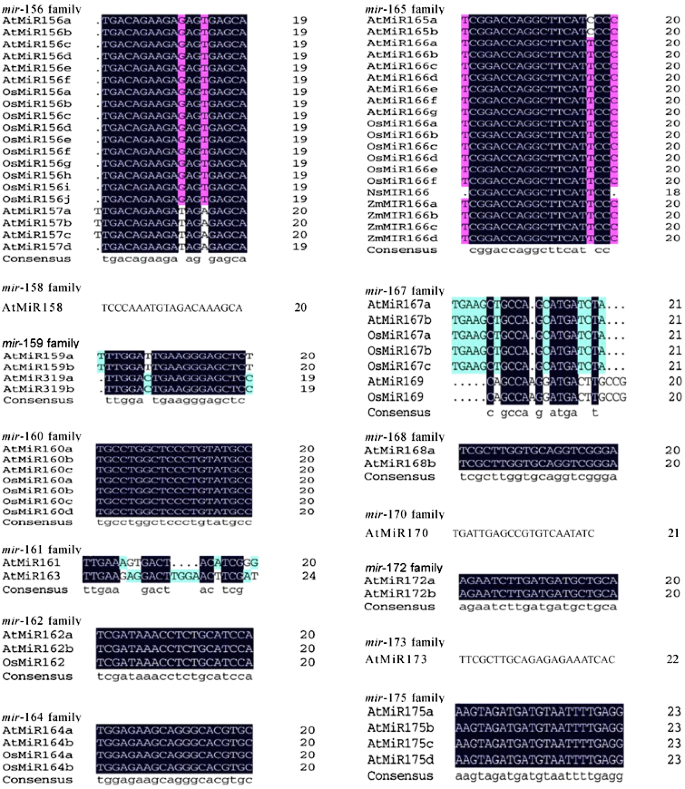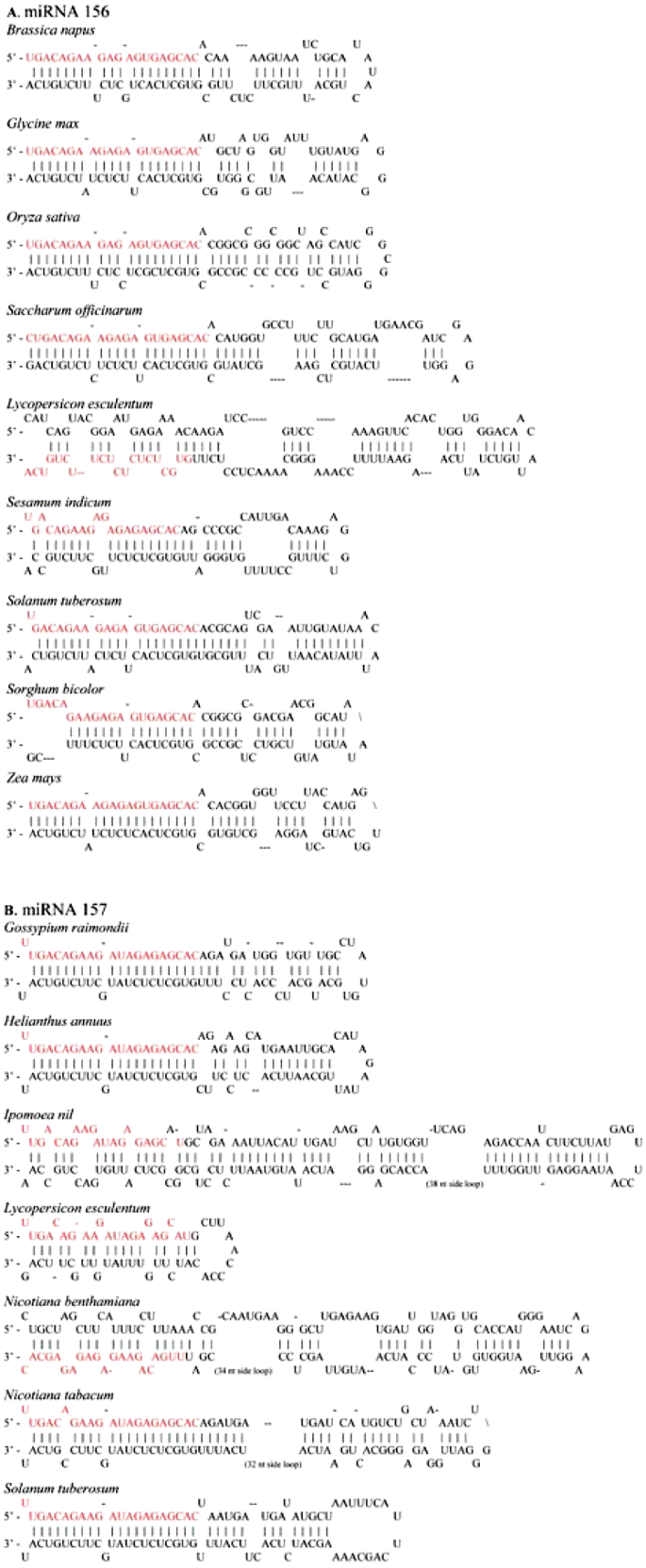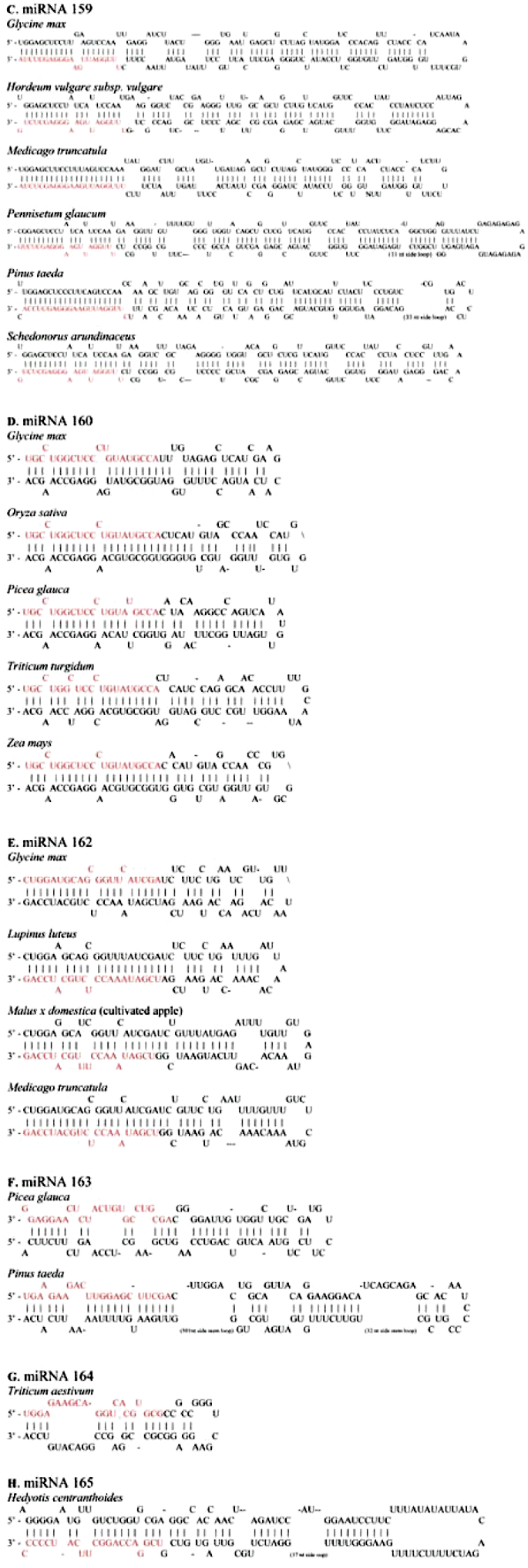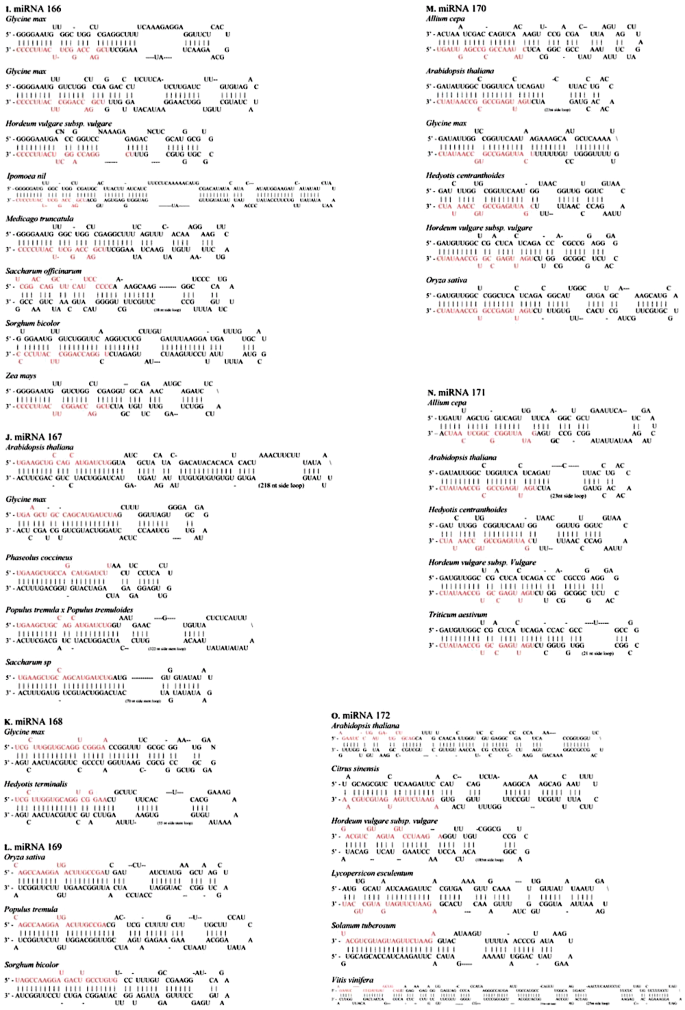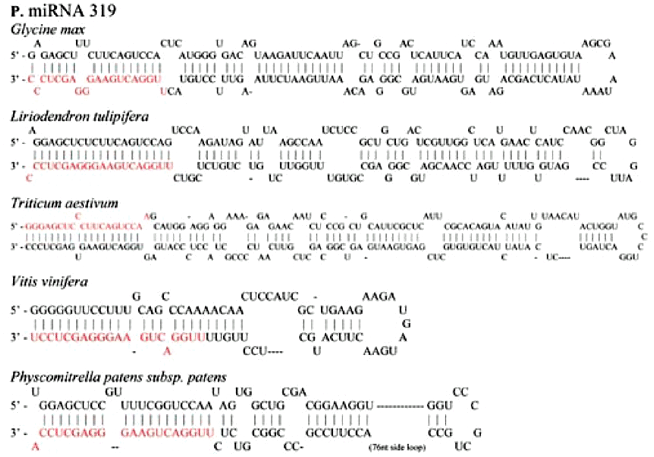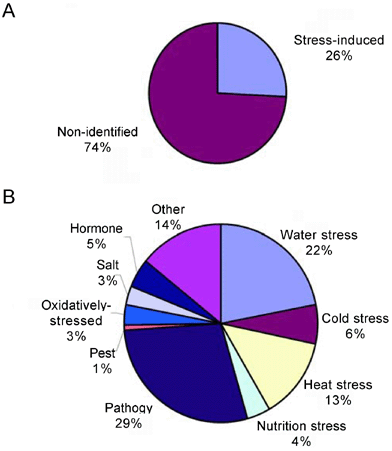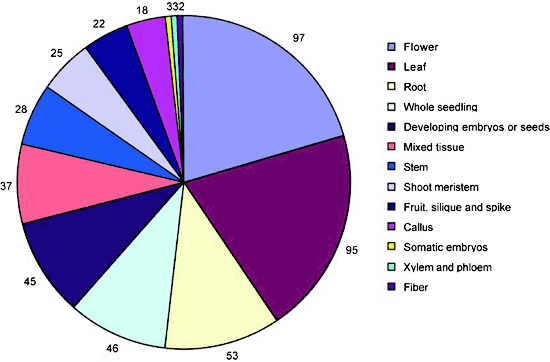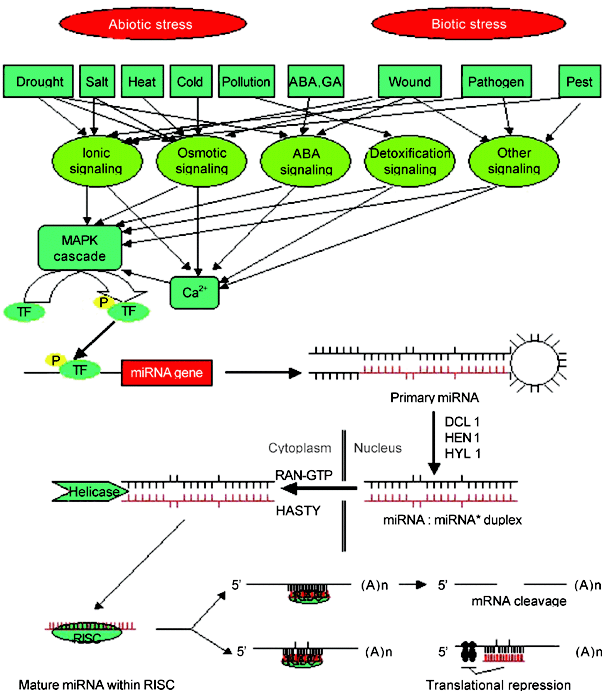Identification and characterization of new plant microRNAs using EST analysis (original) (raw)
INTRODUCTION
MicroRNAs (miRNAs) are a large family of about 21-22 nucleotide non-coding RNAs 1, 2, 3. miRNAs play very important roles in posttranscriptional gene regulation by degradation of target mRNAs or by repression of targeted gene translation in animals, plants, and fungi 1, 2, 3, 4, 5. According to the miRNA Registry Database (Release 3.1, April 2004), 899 miRNA genes have been discovered in various organisms 6. Out of those, 71 miRNA genes have been predicted and identified in plants, of which 43 are from Arabidopsis and 28 from rice (Oryza sativa). After searching the DNA databases (http://www.ncbi.nlm.nih.gov/), we found 4 more miRNA genes discovered in previous reports 7, 8; three (microRNA 166a, b and c) from maize (Zea mays) 7, and one (microRNA 166a) from wood tobacco (Nicotiana sylvestris) 8.
Although miRNAs are one of the hottest research topics in biology, the discovery of miRNAs was dominated by chance and serendipity 9. Currently, most miRNAs were identified by direct cloning of small RNAs 10, 11 or by computational strategies 12, 13, 14, 15, 16, 17. Computational strategies suggest that about 1% of predicted protein-coding genes were miRNAs in metazoan Drosophila 10 and in humans 18, 19, 20. Thus, many miRNA genes still await discovery. Computational strategies provide a useful method to predict miRNA genes and their targets, and have been successfully applied in vertebrates 18, 19, 20, 21, insects 22, Arabidopsis and rice 13, 14, 17, 23, 24. However, many miRNA genes and their targets, especially in plants, still remain undiscovered. The traditional computational approach used was a bit inefficient and certainly not comprehensive, and it is very difficult to demonstrate the expression of these predicted miRNAs using this approach.
Expressed sequence tags (ESTs) are partial cDNA sequences of expressed genes cloned into a plasmid 25, 26. EST analysis has proven to be an economically feasible alternative for gene discovery in species lacking a draft genome sequence 26, and many important genes have been found thorough EST analysis 27, 28, 29. As the number of ESTs dramatically increased and became available in databases, they have become a very powerful tool for discovery of new genes and for solving mysteries in biology 29. As of June 2004, GenBank (National Center for Biotechnology Information, http://www.ncbi.nlm.nih.gov/) contained 22,165,266 entries in its EST database 30. The greatest number of plant entries are for wheat (Triticum aestivum) (552,245), maize (Zea mays) (397,515), barley (Hordeum vulgare plus subsp. Vulgare) (356,856), soybean (Glycine max) (334,668), rice (Oryza sativa) (284,006), and Arabidopsis thaliana (thale cress) (258,825). This large number of ESTs provides a cost-effective and rapid alternative route toward the discovery and isolation of new genes.
Recently, Jones-Rhoades and Bartel (2004) briefly mentioned that they used Arabidopsis microRNA against an EST database to look for potential evidence of miRNAs in other plant species 14. Bonnet et al. (2004) also used an EST database to confirm their 91 new potential microRNAs identified by traditional computational strategies 13. However, they did not do detailed research in this field; they only focused on identifying new miRNAs using a traditional computational strategy. In this paper, based on the analysis of previously known miRNAs, we used EST analysis and DNA database analysis in detail to identify new potential miRNA genes and their targets. Because the ESTs and expressed genes come from the production of true gene expression, our analysis provides more evidence and confidence in the discovery of new potential miRNAs and their targeted genes. Using this strategy, we identified 338 new miRNA candidates in 60 plant species, and 348 genes associated with 348 ESTs targeted by these miRNA candidates. Based on these results, we formed the hypothesis that stress may play an important role in controlling miRNA expression.
MATERIALS AND METHODS
Known plant microRNA analysis
Previously known Arabidopsis (At) and rice (Oryza sativa) (Os) miRNA sequences were obtained from the miRNA Registry Database (Release 3.1, April 2004) 6; maize (Zm) and tobacco (Ns) miRNA were found in publicly available genome databases by comparing all previously known Arabidopsis miRNA to GenBank's DNA databases with BLAST algorithms by Blastn 2.2.9 (May 1, 2004) 31.
Alignments of known plant miRNA were conducted using the DNAMAN software package (Lynnon Corporation, Quebec, Canada J7V 9M5). Phylogenetic trees were reconstructed using the same DNAMAN software with standard parameters.
Searching EST databases, carrying out EST analysis, and predicting the secondary structure of EST sequences
The subgroup of Viridiplantae of the publicly available EST databases was searched using Blastn 2.2.9 (May 1, 2004) 31 by comparing all ESTs to all previously known mature Arabidopsis miRNAs (20-24 base pairs) listed in the miRNA Registry Database (Release 3.1, April 2004) 6. Blast parameter settings were as follows: expect 1000; the number of descriptions and alignments were 1000. All Blast results were saved. EST sequences which closely matched (n/n, n-1/n and n-2/n nucleotide matches, where n equals the previously known Arabidopsis miRNA length) the previously known Arabidopsis miRNAs were chosen, and their secondary structures were predicted and generated using the Zucker folding algorithm with mFold 3.1 32, 33. All mFold outputs including information about the number of structures, free energy (ΔG kcal/mol), miRNA-like helicity, the number of arms per structure, size of helices within arms, and size and symmetry of internal loops within arms were analyzed. The predicted secondary fold-back structures were manually inspected by comparing to the characteristics of previously known miRNAs. The secondary structure of hairpin stem-loop was assigned a score according to the strategies used by Lai et al. (2003) 10. Briefly, free energy (ΔG kcal/mol) and miRNA-like helicity for each individual arm were evaluated and assigned a score. Helicity was calculated +1 for each paired helicity, –1 for each one-nucleotide symmetric loop and –2 for each two-nucleotide symmetric loop, and an overall score was calculated as (helical score + (ABS(ΔG)/2)/2. If there was more than one hairpin stem-loop structure for the ESTs containing the miRNAs, each was scored and the hairpin structure with the highest score was considered the miRNA hairpin stem-loop structure.
Predicted miRNAs and their related information were recorded. Closely related EST sequences were blasted against each other and analyzed. If the ESTs had a high similarity (E value less than e-100), it indicated that these ESTs were created from the same mRNA, and were then considered as one miRNA.
RESULTS
Plant microRNAs are highly conserved
According to the miRNA Registry database (Release 3.1, April 2004) 6, 899 miRNAs have been discovered in various organisms. Out of the 899 genes, 71 miRNA genes have been predicted and identified in plants, of which 43 are from Arabidopsis and 28 from rice. After searching the publicly available DNA databases (http://www.ncbi.nlm.nih.gov/), we found 4 more miRNA genes discovered by Juarez et al. (2004) and McHale and Koning (2004), three from maize 7, and one from wood tobacco (Nicotiana sylvestris) 8.
The four plant species represent both dicots and monocots, two major plant categories. There are different nucleotide identity ratios and related genetic distances among the 75 previously known plant miRNAs (Fig. 1). Some miRNAs are very close to each other, such as miRNA 165 and miRNA 166, where there is only 1 nucleotide difference. Others have long genetic distances and low nucleotide identity (Fig. 1), which may be indicative of their relationship and evolution. The 75 miRNAs were classified into 14 miRNA families based on their nucleotide identity (Fig. 2). In each miRNA family, each member shares the same or similar gene sequences (Fig. 2). In the miRNAs already reported, only miRNA 166 was found in all four plant species. Fig. 1 and 2 show that these miRNAs from different species are highly conserved, and they share the same DNA sequence. These data suggest that miRNAs may have the same ancestor in very early evolution.
Figure 1
Nucleotide sequence identity of 75 previously known microRNAs
Figure 2
Alignments of 75 previously known plant miRNAs that can be grouped into 14 miRNA families. Arabidopsis (At) and rice (Oryza sativa) (Os) miRNA are those identified in the miRNA Registry database (Release 3.1, April 2004); maize (Zea mays) (Zm) and tobacco (Nicotiana sylvestris) (Ns) miRNAs are those found in publicly available genome databases by Blastn against all Arabidopsis miRNA genes.
Identifying new plant microRNAs and their targets
After comparing the gene sequences of 75 previously known miRNAs in different plant species, our results clearly showed that previously known miRNAs are highly conserved (Fig. 1 and 2). In previous reports, several labs have identified some previously known Arabidopsis miRNA homologs in rice 1, 2, 11, 34. Both our results and other reports suggested that different plant species share similar miRNA sequences. Based on these results, in this study, we employed EST analysis to identify new miRNAs in other plant species. Our strategy included the following three steps. First, we searched the EST databases to find ESTs matched with the previously known Arabidopsis miRNAs. Then we predicted the secondary structures of the identified ESTs in the first step using RNA mFold software. Finally, we identified new miRNAs.
First, we searched the plant EST databases using Blastn 2.2.9 (May 1, 2004) 31 against all known Arabidopsis miRNA genes listed in the miRNA Registry database (Release 3.1, April 2004) 6. A total of 18,694 Blast hits were found in the databases. To avoid a miscount of the total EST sequences, ESTs with n-2, n-3, n-4, and n-5 mismatched nucleotides with previously known miRNA were chosen and paired with the known miRNA sequences. After removing the EST sequences with high numbers (more than 2) of mismatched hits, we obtained 171, 440, and 201 ESTs with 0, 1, and 2 mismatched nucleotides, respectively (Tab. 1 and 2). This provided a total of 812 ESTs for predicting the RNA secondary structures using RNA mfold software.
Table 1 Summary of plant EST blast hits to known plant miRNA sequences
Table 2 ESTs with high base pair identity to previously known Arabidopsis miRNAs
EST hits differ in EST databases among previously known miRNAs. miRNAs 156 and 157 received the highest number of EST hits, each more than 200 with 0-2 mismatched nucleotides; the 24 and 18 ESTs containing completely conserved sequences were received for miRNAs 156 and 157, respectively. miRNAs 161 and 163 did not receive any EST hits with 0-2 mismatched nucleotides. Although miRNAs 171 and 166 only received 65 and 32 EST hits, respectively; they received the highest number of EST hits without nucleotide change. This indicates that the expression of different miRNAs and their number of copies in a plant genome may differ. The higher the number of EST hits, the more copies of the miRNA genes. This also indicates that there is a very high rate of divergence occurring for some miRNAs even if some are highly conserved.
The next step in this study was to predict the secondary structure of all 812 chosen ESTs with 0-2 mismatched nucleotides with previously known Arabidopsis miRNAs, and to identify the new miRNAs and their targeted genes based on the main represented characteristics of miRNAs and their targeted genes. After individually checking and scoring the secondary structure of the 812 chosen ESTs, 464 EST contigs were found to have the patterns of secondary structure conservation resembling those of previously known plant miRNAs (Fig. 3). These 464 ESTs were grouped into 17 families and represented 338 new potential miRNAs in 60 plant species based on their nucleotide sequence similarity as determined by Blastn (Tab. 1 and 3). The other 348 chosen ESTs may be the targets of our newly identified or previously known miRNAs (Tab. 2 and 3).
Figure 3
Examples of the predicated stem-loop structure of newly identified plant miRNA precursors using EST analysis. The miRNA sequences are in grey. The actual size of the precursors may be slightly longer. (A) miRNA 156; (B) miRNA 157; (C) miRNA 159; (D) miRNA 160; (E) miRNA 162; (F) miRNA 163; (G) miRNA 164; (H) miRNA 165; (I) miRNA 166; (J) miRNA 167; (K) miRNA 168; (L) miRNA 169; (M) miRNA 170; (N) miRNA 171; (0) miRNA 172; (P) miRNA 319.
Table 3 New miRNAs identified from plants
Out of 171 ESTs without mismatched nucleotides that were compared with previously known Arabidopsis miRNAs, 72.5% of ESTs (124) were predicted to have the secondary structure of miRNA and were identified as new potential miRNAs. Only 53.4% and 52.2% of ESTs had the secondary structure of miRNAs and were identified as new potential miRNAs in the ESTs with 1 or 2 nucleotide substitutions relative to their Arabidopsis miRNA homologs. This also indicated that plant miRNAs are highly conserved.
To avoid designating small RNAs or fragments of other RNAs as miRNAs, Ambros et al. (2003) developed a combination of criteria to identify and annotate new miRNAs 35. The combination of criteria includes both expression criteria and biogenesis criteria. The potential miRNAs identified by EST analysis were highly conserved with the known Arabidopsis miRNAs, and fit the miRNA criteria of secondary struture. Thus, the newly identified potential miRNAs fit the biogenesis criteria well. ESTs are partial cDNA sequences of expressed genes. If this was counted to expression criteria, all new identified potential miRNAs should be true miRNAs. However, to avoid the possibility of artefactual ESTs 36, a Northern blotting method should be employed to test these new potential miRNAs. However, these newly identified gene sequences are still very good miRNA candidates.
In this study, we identified a total of 464 ESTs containing new potential plant miRNAs. Out of those ESTs containing potential miRNAs, 98, the highest number, belong to the miRNA 156 family; 53 belong to the miRNA 157 family; and 48 belong to the miRNA 172 family. miRNAs 156, 157, 159, and 172 are four well studied plant miRNAs. They have important functions in plant development, especially in leaf and flower development. The expression of miRNAs 161 and 163, and their targeted genes are unclear. We did not find any ESTs with 0-2 base substitutions related to these two Arabidopsis miRNAs. However, we found 31 ESTs with 20 matched nucleotides and 4 nucleotide substitutions related to Arabidopsis miRNA 163, and 12 of the 31 ESTs were predicted to have the secondary structure of miRNA, and were identified as new miRNAs. These 12 ESTs expressed 2 miRNAs and belonged to 3 plant species: Picea glauca, Picea sitchensis, and Pinus taeda.
To avoid ESTs created from the same miRNA precursor, ESTs containing the same length hairpin structure were blasted in dbEST against each other. If the ESTs have high similarity, it indicates that these ESTs were created from the same miRNA sequence and they should be considered as one miRNA. After removing the homezygotic ESTs containing the same miRNA, a total of 338 new potential miRNAs were identified in 60 plant species (Fig. 3). The highest number of new potential miRNAs, 45, was found in soybean (Glycine max), followed by rice (Oryza sativa) with 25, sugarcane (Saccharum officinarum) with 25, maize (Zea mays) with 23, and wheat (Triticum aestivum) with 19 (Tab. 4). All of these plant species have more than 200,000 EST sequences in the GenBank's EST databases.
Table 4 ESTs matched by known Arabidopsis miRNAs, and identified as new miRNAs in plants
Some microRNAs may be induced and regulated by environmental stress; some preferentially express in specific tissues and may be regulated by developmental switching
Out of the 476 identified EST contigs containing miRNAs, 123, or 25.84 %, were found in stress-induced plant tissues (Fig. 4A). These environmental stresses included abiotic and biotic stresses, such as drought, heat, cold, salinity, pathogen infection, or pests. In the 123 EST contigs, 36 (29%) EST contigs were associated with pathogen infection; 28 (22%) were associated with water stress; and 25 (19%) were associated with temperature stress. Other stresses, such as nutrition deficiency, salinity, and oxidative stress produced 4%, 3%, and 3% EST contigs, respectively (Fig. 4B). Abscisic acid (ABA) is considered a plant stress hormone, and jasmonic acid (JA) and salicylic acid (SA) are believed to be related to plant response to environmental stress. In this study, we found that 6 of the 123 EST contigs were created from the tissue induced by ABA, JA, SA, or other hormones. The other 18 (14%) EST contigs were created from the tissues induced by other abiotic and biotic environmental stresses, such as darkness or oxygen deficiency, wound treatment, acid- or alkaline-treatment.
Figure 4
miRNAs are induced and regulated by environmental biotic and abiotic stresses. (A) 26% of ESTs were obtained from stress-induced tisssues. (B) ESTs containing miRNAs were obtained from tissue by various biotic and abiotic environmental stresses.
Among all of the plant ESTs included in the TIGR database, 23% were from different stressed tissues. Here we found that 25.84 % of total ESTs containing potential miRNA were obtained from stress-induced plant tissues. Does this really mean that these microRNAs were induced by stress? More experiments need to be done to confirm this. However, recently three reports have confirmed our hypothesis. miRNA 159, 319, 395 and 402 were regulated by GA, cold, water and sulfate starvation stress, individually 11, 14, 37.
Expression of plant miRNAs appears to be developmental or tissue specific. miRNAs are somewhat more strongly expressed in seedlings than in adult plants. Out of the 449 identified EST contigs which contain miRNAs and indicate origin tissues, 43 ESTs were obtained from young seedlings, but only 3 from adult plants (Tab. 5). Early and rapid growth stages may need more miRNA to regulate their gene expression. This is confirmed by recent reports 11, 23, 34. In previous investigations, most miRNAs have been found to be strongly expressed in floral and leaf tissues 7, 11, 34, 38, 39, 40, 41. This observation was also supported by this study. Out of the 338 newly identified miRNAs in 60 different plant species, the majority were found in flowers and leaves. Fewer were found in roots, developing embryos, seeds or other tissues (Fig. 5 and Tab. 5). This indicates that miRNAs play important roles in plant growth and development other than controlling leaf and floral development 7, 11, 34, 38, 39, 40, 41. However, different miRNAs have different expression patterns. miRNA 157 preferentially expresses in flowers, but miRNAs 160, 163, and 168 preferentially express in leaves rather than in other tissues. miRNAs 156, 159, and 172 preferentially express in both flowers and leaves. miRNA 163 preferentially expresses in roots. Although we obtained EST contigs containing miRNAs from other tissues, it did not appear that these miRNAs preferentially express in those tissues (Tab. 5). However, they may play other roles in those tissues in regulating expression of certain genes. In this study, miRNAs also have been found to be expressed in other tissues, such as roots, vascular tissues, stems, callus, somatic embryoes and fibers. This suggests that miRNAs play some role and regulate certain gene expression in these tissues.
Table 5 Tissue-specific expression of plant miRNAs
Figure 5
Preferential expression of miRNAs
In the EST database, ESTs were unequally obtained from different tissues. Some tissues may contribute more ESTs than other tissues. Thus, more experiments need to be conducted to confirm this conclusion. However, this approach gave us more clues to study plant microRNAs, and this strategy alleviates the usually difficult step of predicating the correct tissues and conditions to search for expression evidence in a directed manner.
DISCUSSION
miRNAs are widespread and highly conserved in the plant kingdom, and they may have the same ancestor in very early evolution
miRNAs are widespread in plant species and eukaryotes. In previous studies, 71 miRNAs have been reported in Arabidopsis and rice. Out of the 71 miRNAs, 43 were predicted and identified in Arabidopsis, and 28 in rice (the miRNA Registry database, Release 3.1, April 2004). In this study, we found 338 new miRNAs in 60 plant species using EST analysis and BLAST algorithms. With improvements in the strategy and technology for identifying miRNAs, more miRNAs will be discovered. In metazoans, such as Drosophila and humans, computational strategy suggests that miRNAs constitute nearly 1% of predicated protein-coding genes. In comparison with animals, a distinguishing feature of plants is that they are sessile and thus have to cope with, rather than move to avoid, complicatedly adverse environments and invasion of animals 47. Plants should therefore have more complicated mechanisms to control gene expression and gene regulation. If miRNAs are involved in these mechanisms, there should be more miRNAs in plant genomes than in animal genomes. Arabidopsis is a model plant species for genome research; its genome sequence was published in 2000 42. The Arabidopsis Information Resource (TAIR) shows that Arabidopsis has currently 21,316 proteins (http://www.arabidopsis.org/tools/bulk/protein/index.jsp) excluding proteins of unknown subcellular location and chloroplast- and mitochondrion- targeted proteins. If plants have the same 1% miRNAs in their genome, Arabidopsis should have 213 miRNA genes. However, only 43 miRNAs have been reported in previous studies, plus the 17 newly discovered miRNAs candidates in this report; 60 miRNAs have been discovered in Arabidopsis. This is far from 1.0% of the protein-coding genes, so more miRNAs still await discovery in plants.
miRNAs are highly conserved among different plant species, including dicots and monocots. There is no nucleotide base substitution in the majority of miRNA families from different plant species. Some species only have a few (0-2) nucleotide base substitutions with Arabidopsis miRNAs. This suggests miRNAs may have the same ancestor in early evolution. However, some microRNAs may have a very high rate of divergence even if some are highly conserved.
Stress may play an important role in miRNAs regulation
It is a complicated mechanism for both animals and plants to respond to stress. In this specific response, miRNA may be involved. In animals, loss of function of miR 14 increased sensitivity of fly to different stresses 43, and nutrient stress may induce expression of miRNA 234 19. In this study, we found 26% of EST contigs containing miRNAs are related to different biotic or abiotic environmental stresses, and out of these ESTs, 22% related to water stress, 19% related to temperature stress, and 29% related to pathogen infection (Fig. 4). These data suggest that environmental stress may play an important role in miRNA gene expression in plants. This conclusion is also supported by recent reports 11, 14, 37. Jones-Rhoades and Bartel (2004) showed that sulfate starvation induced overexpression of miRNA 395 14. The experiment by Sunkar and Zhu (2004) showed that miRNA 402 is strongly overexpressed under the condition of dehydration, cold, salt stress, or ABA treatment 11. However, miRNA 319 is induced by cold 11, and miRNA 159 is regulated by GA 37.
Biotic and abiotic stress may function as signals to control and to regulate miRNA genes in plants (Fig. 6). First, these biotic or abiotic stressors form different signaling in plant cells, then induce a Ca2+ signal or MAPK signal which interacts with a transcriptional factor, and produces down or over expression of the targeted miRNA genes (Fig. 6). The study of specific responses of miRNAs to environmental stress will help us improve plant resistance to environmental stresses, especially disease, drought, and salinity stress.
Figure 6
A model for miRNA biogenesis, regulation of miRNA gene regulation, and the pathway of miRNA function.
Another function of miRNAs may be involved in signal transduction. In this study, we found 7 ESTs containing miRNAs are associated with ABA or other hormone signaling. After we searched the NSF 2010 Arabidopsis Small RNA Project database (http://cgrb.orst.edu/smallRNA/) of small known RNAs and compared all previous known Arabidopsis miRNA to ABA signaling related genes with BLAST algorithms, we found miRNAs may be involved in the regulation of the ABA signaling genes.
Although several studies have tried to determine what produces microRNAs, little is known regarding miRNA biogenesis in plants. The data in this study suggest that environmental stresses and developmental switching may function as signaling to induce pri-miRNA transcription by RNA polymerases (Fig. 6). After pri-miRNAs are synthesized, they are processed to miRNA precursors or pre-miRNAs by the double-stranded RNase DICER-LIKE (DCL) 7, 34, 41. Finally, the cleaved pre-miRNA will be translocated into cytoplasm by a HASTY protein, and cleaved into mature miRNAs (Fig. 6). In the cytosol, miRNA regulate gene expression at posttranscriptional levels by miRNA cleavage or by translational repression 2. In animals, both of the two regulatory mechanisms are common on repression of target gene expression 2. In plants, the majority of miRNAs interact with the internal regions of target mRNAs through perfect or near perfect base-pairing to cleave the mRNAs 1, 39, 44. However, for some miRNAs, such as miRNA 172, although they have perfect or near-perfect complimentarity sequence with target mRNAs, they inhibit the expression of target genes by binding to a unique site located within the open reading frame of the target mRNAs rather than miRNA cleavage 38, 45.
False positives
Existence of false positives is one problem in many studies. To reduce the number of false positives, we combined multiple methods in this study. This is similar to that described by Bonnet et al. 13. First, the number of EST hits is dramatically reduced after comparing EST sequences to previously known Arabidopsis miRNA sequences. According to the characteristic that plant miRNAs are highly conserved and only a few nucleotides change between plant species, ESTs with only 0-2 mismatched nucleotides with previously known Arabidopsis miRNA were considered as potential miRNA candidates. Second, potential ESTs were reduced about 50% by considering the secondary structure parameters based on previous reports [1, 2, 11, 13, 34, 46]. Third, the number of miRNAs was reduced by considering potential miRNA target genes in the DNA database. Fourth, repeated ESTs were removed by comparing similar EST sequences. Fifth, to avoid a miscount of the total EST sequences, ESTs with n-2, n-3, n-4, and n-5 mismatched nucleotides with previously known miRNA were chosen and paired with known miRNA sequences. Sixth, the matched ESTs were blasted against a database of known proteins to kick out the potential ESTs which actually code a protein rather than a structural RNA. After these six steps and other combined strategies, the number of EST hits dramatically reduced from 18,694 to 384. This gave us more confidence in identifying miRNAs.
If these identified miRNAs are confirmed by experimental evidence, such as northern blotting, it will give us more confidence in the newly identified miRNAs and the hypothesis that stress may play an important role in miRNA regulation. However, ESTs are the true products of gene expression, and in some case they may be considered as the result of northern blotting. Actually, Smalheiser 36 successfully predicted the existence of a population of chimeric microRNA precursor-mRNA transcripts expressed in normal human and mouse tissues only by EST analysis. Bonnet et al. 13 used the EST database to confirm their 91 potential Arabidopsis and rice miRNAs identified by a computational strategy, and several genes have been identified by only EST analysis 27, 28, 29. Thus, we have confidence in these identified miRNAs by EST analysis. EST analysis also gave us more information on miRNAs in other plant species in which it was impossible to identify miRNAs by traditional computational strategy due to lack of a DNA sequence. Finally, EST analysis provides information for designing more new experiments to understand miRNAs 36.
